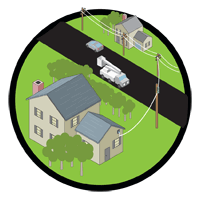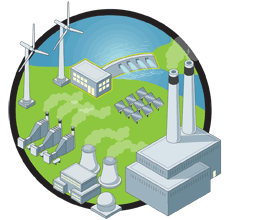 Clamps and vices are made for holding things stable. But you don’t have to be a master carpenter to know that when too much pressure is applied while using them, the object between the grips can crack, crimp or warp. The result is the opposite effect: the object becomes destabilized and damaged.
Clamps and vices are made for holding things stable. But you don’t have to be a master carpenter to know that when too much pressure is applied while using them, the object between the grips can crack, crimp or warp. The result is the opposite effect: the object becomes destabilized and damaged.
Electric utilities are in a similar place. Electric rates generally are held stable by balanced supply and demand combined with even-handed regulations and policies. But pressures from new government regulations, rising fuel and materials costs, escalating demand for electricity, and required investments in both adding generation as well as upgrading existing power plants have been increasing over the last decade.
While the current economic downturn eased some of the grip — such as causing electric demand to dip — this respite may just mark the “calm before the storm” when financial fortunes rebound. Then, pressure from all these factors is expected to once again begin ratcheting down on electric utilities, including the 39 consumer-owned, not-for-profit electric cooperatives — the REMCs and RECs — in Indiana.
Let’s step into the ratemaking boiler room to explore the pressure points at play in your electric bill.
1. Pressure Point: Growing Electric Demand
The U.S. Department of Energy predicts by 2030 residential demand for electricity will increase between 16 percent and 36 percent above 2007 levels. Historically, electric co-op demand rises faster than the industry average — before the recession hit, co-op sales increased between 2006 and 2007 by 4.4 percent while industry sales only increased by 2.6 percent.
 The U.S. Energy Information Administration predicts industry demand will rebound by 5 percent in 2010 and estimates that with strong economic growth, electricity prices will jump 19 percent by 2035. However, the forecaster fails to factor in added costs of complying with new federal regulations aimed at curbing emissions of greenhouse gases, such as carbon dioxide, from power plants.
The U.S. Energy Information Administration predicts industry demand will rebound by 5 percent in 2010 and estimates that with strong economic growth, electricity prices will jump 19 percent by 2035. However, the forecaster fails to factor in added costs of complying with new federal regulations aimed at curbing emissions of greenhouse gases, such as carbon dioxide, from power plants.
In its 2009 projection, the State Utility Forecasting Group lowered its demand projections from 2007’s report in the short term, citing the economic recession and increased efforts in energy efficiency.
The 2009 forecast projects electricity use in the state to grow at a rate of 1.55 percent per year over the next 20 years. Peak electricity demand is projected to grow at an average rate of 1.61 percent annually.
Hoosier Energy, the Bloomington-based generation cooperative that supplies power to the electric co-ops in the southern half of Indiana, forecasts energy sales and summer peak demand to increase at just a slightly higher rate than the overall state forecast. Hoosier Energy forecasts an average increase in demand to be about 1.9 percent annually through 2028.
2. Pressure Point: Added Regulation
The U.S. Environmental Protection Agency will begin regulating greenhouse gases, such as carbon dioxide, this month — an action made possible by a 2007 U.S. Supreme Court decision that gave the agency a green light to consider imposing such controls. In late 2009, EPA declared that six greenhouse gases, including carbon dioxide, “endanger the public health and welfare” of current and future generations.
Although carbon dioxide measures crowd headlines, the cumulative impact of new federal mandates for handling coal ash, water, and limiting hazardous air pollutants along with state (and perhaps federal) requirements for renewable energy generation could become a much more expensive hurdle for the electric utility industry.
During the past 20 years, EPA has used the federal Clean Air Act to slash nationwide emissions of nitrogen oxides, which contribute to smog, by 54 percent, and cut acid rain-causing sulfur dioxide emissions by 42 percent. That’s an impressive reduction, considering electricity use rose 64 percent over the same period. However, proven technology existed to achieve those results — something not currently available for removing carbon dioxide and other items under scrutiny.
“The Clean Air Act as written was never designed to deal with carbon dioxide, and it could be awkward at best and probably a disaster, at worst,” warned Glenn English, CEO of the Arlington, Va.-based National Rural Electric Cooperative Association.
“We’re entering an era where regulatory activities are going to play a more significant role in the electric industry than what happens on the legislative front,” asserted Kirk Johnson, NRECA vice president of energy and environmental policy. He noted Congress has debated climate change policy for more than a decade without reaching a clear consensus. “Environmental statutes that have been on the books since the 1970s, especially the Clean Air Act, are like a one-way ratchet: they only tighten.”
Tighter emissions standards could have a multi-billion dollar impact on the cost of doing business for electric co-ops, adding more pressure to electric bills.
3. Pressure Point: Need for New Generation
Even as new regulations are announced, utilities must be ready to make quick decisions on moving forward with power plants to meet growing electricity demand — especially since the number of operating plants may start to fall.
 “Because of these new [EPA] rules, we’re expecting a number of existing power plants to simply be retired,” predicted Johnson. “The cost to comply with the rules will simply be too much.”
“Because of these new [EPA] rules, we’re expecting a number of existing power plants to simply be retired,” predicted Johnson. “The cost to comply with the rules will simply be too much.”
The North American Electric Reliability Corporation, which oversees the reliability of the bulk power system covering the United States and most of Canada, estimates that by 2017 peak demand for electricity will jump 135,000 MW — equivalent to the current amount of power used by the entire western half of the nation. Planned new generation resources will only provide another 77,000 MW, far short of the energy Americans will need.
Co-ops are working hard to relieve some pressure and delay the need for new plants through energy efficiency programs. Most co-ops offer efficiency education; 77 percent provide energy audits while 49 percent offer financial incentives for members to make efficient choices. But these measures can only go so far.
“When the economy turns around, co-ops will resume growing faster than other utilities,” English said. “We’ve got to be ready for that development and have power plants planned and largely ready to go. However, co-ops must first know how carbon dioxide and other rules could impact the price of power to make prudent decisions.”
4. Pressure Point: Cost of Materials
Every year investments in new power plants are delayed jacks up the final price tag. Worldwide, steel prices soared 42 percent between 2009 and 2010 while costs for other construction supplies like nickel and concrete jumped as well.
Material costs for co-ops are also climbing. Prices for copper, a critical raw material used for wire and to ground electrical equipment, reached a 27-month high in 2010. Between 1990 and 2010 in the north-central part of America the price tag on utility poles, towers, and fixtures skyrocketed 98 percent while line transformers spiked 154 percent.
“Electric co-ops have an obligation to keep the lights on and electric bills affordable at a time when the costs for fuel and raw materials to build new generation are steadily rising,” said English. “Combined with costs of additional regulatory compliance, these are just some of the pressure points that will affect electric bills in years to come — all of which are largely beyond the control of local electric co-ops.”
This article was written by Megan McKoy-Noe, who writes for the National Rural Electric Cooperative Association, the Arlington, Va.-based service arm of the nation’s 900-plus consumer-owned, not-for-profit electric cooperatives. Steve Johnson and Electric Consumer staff contributed to this article.



